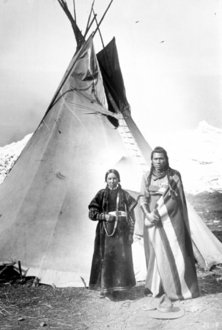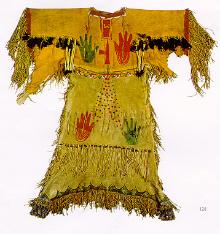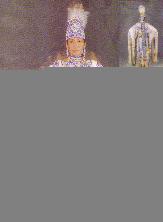
| Overview of Native American Clothing |
Native Americans took the task of making clothing more seriously than European
settlers. They used primarily animal hides, which they had to hunt, skin and work the hide
to the proper softness before it could be made into a shirt, pants, or warm winter coat.
In Native cultures where a girl or woman might wear the same dress for years, dresses
were designed and decorated not only to be aesthetically pleasing but also to give
specific information about the wearer.
Certain symbols on a dress referred to the woman's tribe, her marital status, and, for
example, the prowess of her husband or father as a hunter or trader. Since elk have at
most two eyeteeth, a dress adorned with dozens or even hundreds of elk eyeteeth
signaled that the men in the family were skilled hunters.
settlers. They used primarily animal hides, which they had to hunt, skin and work the hide
to the proper softness before it could be made into a shirt, pants, or warm winter coat.
In Native cultures where a girl or woman might wear the same dress for years, dresses
were designed and decorated not only to be aesthetically pleasing but also to give
specific information about the wearer.
Certain symbols on a dress referred to the woman's tribe, her marital status, and, for
example, the prowess of her husband or father as a hunter or trader. Since elk have at
most two eyeteeth, a dress adorned with dozens or even hundreds of elk eyeteeth
signaled that the men in the family were skilled hunters.


Identity by Design: Tradition, Change and Celebration in Native Women's Dresses, an
exhibition of fifty-five dresses recently shown (September 26, 2008 -- September 13,
2009) at the George Gustav Heye Center of the Smithsonian's National Museum of the
American Indian in New York City, is an excellent introduction to the beauty, complexity
and artistry of Native dresses from the early 1800s to today. The exhibition comes
mostly from the museum's collection, although there are also dazzling contemporary
dresses made by six living Native women who are keeping traditional sewing and
beadwork alive through their work with Native cultural organizations. The historic
dresses come from the Plains, Plateau and Great Basin regions of the United States and
Canada, which are regions west of the Mississippi.
exhibition of fifty-five dresses recently shown (September 26, 2008 -- September 13,
2009) at the George Gustav Heye Center of the Smithsonian's National Museum of the
American Indian in New York City, is an excellent introduction to the beauty, complexity
and artistry of Native dresses from the early 1800s to today. The exhibition comes
mostly from the museum's collection, although there are also dazzling contemporary
dresses made by six living Native women who are keeping traditional sewing and
beadwork alive through their work with Native cultural organizations. The historic
dresses come from the Plains, Plateau and Great Basin regions of the United States and
Canada, which are regions west of the Mississippi.
Beautifully Dressed Kiowa Women
in 1890
in 1890
Part of what is so impressive about these historic
who made them. Talk about DIY! (Today's
"do-it-yourself" movement.) To make some of the
oldest dresses in the exhibition, those dating from
the early 1800s, a single animal hide was folded in
half. The two edges were then sewn to create a
straight tube dress. Practical as they were, the
straight, relatively narrow dresses made it difficult
women in nomadic tribes began making two-hide
dresses.
The hides came from elk, deer and big horn sheep
and by sewing two together along the edges of the
hides with the tail end of the animal at the top of
dress. Designers of hide dresses left the tail of the
animal intact and the tail became a highly desirable
embellishment at the wearer's neckline. Later in the
century it became fashionable to remove the tail
from the hide and to replace it with intricate
beadwork at the neckline. Two-hide dresses
eventually evolved into three-hide dresses, in which
a third hide was folded like a short cape over the
A-line, two-hide garment.
The dresses were utilitarian. They were warm,
tough and relatively weather-hardy. But to create
style, both tribal and personal, the women used
porcupine quills, bits of tin, carved bone, animal
sinew, coins, animal teeth, fossilized shells, and the
brightly colored glass beads that traders brought
from the glass factories of Venice or what is now
the Czech Republic. Thousands of hours went into the
embellishment on many of these dresses, and by the
late 1800s, the entire yoke of a woman's dress was
sometimes covered with beads. One of the most
glorious dresses in the show is a Sioux two-hide
dress from about 1865 with a fully beaded yoke in
an abstract yellow, white, black, blue, and red
pattern.
Above: Sioux Indian Dress, 1890. Made from hide
and beaded with Czech beads.
By the mid-nineteenth century, dresses made of
what was often called "Indian" cloth were common.
Mills in England wove wool specifically for trading
with Native Americans. The wool was usually vivid
scarlet or dark blue and the undyed selvage at the
edges of the cloth was ingeniously incorporated into
the design of the dresses. By the late nineteenth
century Native women often added rows of ribbon,
shells or beads above the undyed selvages to add
another design element. One stunning dress in the
exhibition is the Crow Elk Tooth Dress, circa 1890,
from Montana. Made of red and green wool, it is
adorned with imitation elk teeth (carved from bone),
and seed beads.
Of special note are the three Ghost Dance dresses
dating from the end of the nineteenth century, a
time when Native culture was increasingly under
pressure to assimilate into the European-based
culture of the 100 year old United States. The
dresses are made of muslin and painted with battle
scenes meant to honor warriors. According to the
exhibition's curators, it is most likely that men did
the painting. The scenes are dramatic and heroic,
though the dresses themselves are by necessity
much simpler garments than those decorated with
beads and other adornment. Because Ghost Dances
were associated with the massacre of Natives at
Wounded Knee, Native elders rarely allow the
dresses to be exhibited.
As a coda to the historical garments, the outfits
made by the living Native artisans are a testament
to the power of cultural identity. Though the outfits
are more elaborate and embellished than the
historical dresses, they too are designed to identify
the wearer and to honor the history of her Native
culture. A dress such as the magnificent one
designed in 2005 by Keri Jhane Myers, of the
Comanche nation, is a reminder that these dresses
are still being created with pride, joy and
consummate artistry.
who made them. Talk about DIY! (Today's
"do-it-yourself" movement.) To make some of the
oldest dresses in the exhibition, those dating from
the early 1800s, a single animal hide was folded in
half. The two edges were then sewn to create a
straight tube dress. Practical as they were, the
straight, relatively narrow dresses made it difficult
women in nomadic tribes began making two-hide
dresses.
The hides came from elk, deer and big horn sheep
and by sewing two together along the edges of the
hides with the tail end of the animal at the top of
dress. Designers of hide dresses left the tail of the
animal intact and the tail became a highly desirable
embellishment at the wearer's neckline. Later in the
century it became fashionable to remove the tail
from the hide and to replace it with intricate
beadwork at the neckline. Two-hide dresses
eventually evolved into three-hide dresses, in which
a third hide was folded like a short cape over the
A-line, two-hide garment.
The dresses were utilitarian. They were warm,
tough and relatively weather-hardy. But to create
style, both tribal and personal, the women used
porcupine quills, bits of tin, carved bone, animal
sinew, coins, animal teeth, fossilized shells, and the
brightly colored glass beads that traders brought
from the glass factories of Venice or what is now
the Czech Republic. Thousands of hours went into the
embellishment on many of these dresses, and by the
late 1800s, the entire yoke of a woman's dress was
sometimes covered with beads. One of the most
glorious dresses in the show is a Sioux two-hide
dress from about 1865 with a fully beaded yoke in
an abstract yellow, white, black, blue, and red
pattern.
Above: Sioux Indian Dress, 1890. Made from hide
and beaded with Czech beads.
By the mid-nineteenth century, dresses made of
what was often called "Indian" cloth were common.
Mills in England wove wool specifically for trading
with Native Americans. The wool was usually vivid
scarlet or dark blue and the undyed selvage at the
edges of the cloth was ingeniously incorporated into
the design of the dresses. By the late nineteenth
century Native women often added rows of ribbon,
shells or beads above the undyed selvages to add
another design element. One stunning dress in the
exhibition is the Crow Elk Tooth Dress, circa 1890,
from Montana. Made of red and green wool, it is
adorned with imitation elk teeth (carved from bone),
and seed beads.
Of special note are the three Ghost Dance dresses
dating from the end of the nineteenth century, a
time when Native culture was increasingly under
pressure to assimilate into the European-based
culture of the 100 year old United States. The
dresses are made of muslin and painted with battle
scenes meant to honor warriors. According to the
exhibition's curators, it is most likely that men did
the painting. The scenes are dramatic and heroic,
though the dresses themselves are by necessity
much simpler garments than those decorated with
beads and other adornment. Because Ghost Dances
were associated with the massacre of Natives at
Wounded Knee, Native elders rarely allow the
dresses to be exhibited.
As a coda to the historical garments, the outfits
made by the living Native artisans are a testament
to the power of cultural identity. Though the outfits
are more elaborate and embellished than the
historical dresses, they too are designed to identify
the wearer and to honor the history of her Native
culture. A dress such as the magnificent one
designed in 2005 by Keri Jhane Myers, of the
Comanche nation, is a reminder that these dresses
are still being created with pride, joy and
consummate artistry.

Native American Plains Indians, 1880.
Photos courtesy of the Library of Congress and
the Denver Public Library Archives.
the Denver Public Library Archives.

Native American Clothing of
Iroquois, 1890
Iroquois, 1890
Yakama Indian two-hide dress, ca. 1890.
Made from cowhide, pony beads, faceted
Russian glass beads, fire-polished glass
beads, cut glass beads, seed beads,
sinew.
Made from cowhide, pony beads, faceted
Russian glass beads, fire-polished glass
beads, cut glass beads, seed beads,
sinew.


Crow-Elk Tooth Dress, 1890

Plains Indian Ghost Dance Dress, 1890


Comanche Dress

